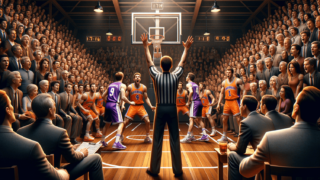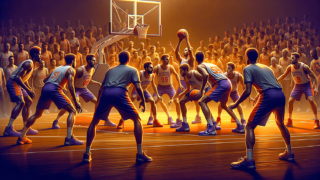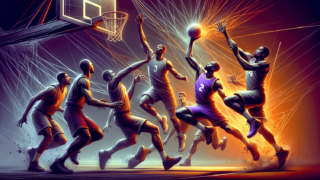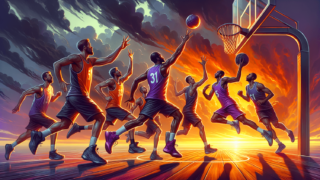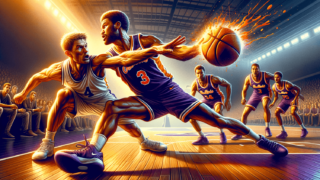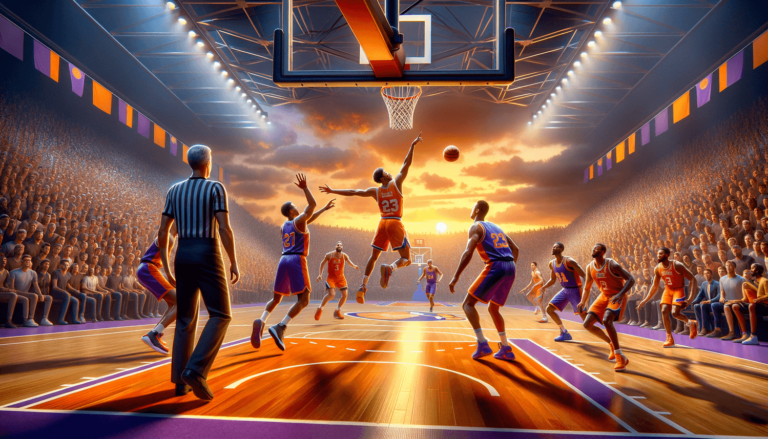
And-One Rule in Basketball: How It Works
Written by: Basketball Universe
Last updated:

Get ready for an exciting, behind-the-scenes look at one of the most thrilling elements of basketball: the “And-One” rule! This fascinating concept takes a blend of athleticism, determination, and timing, and has become an essential part of the game for both players and fans. Whether you’re a basketball newbie or a seasoned basketball aficionado, by the end of this post, you’ll have a comprehensive understanding of the And-One rule, its mechanics, and its strategic importance in the game. So buckle up, folks, as we dive into the captivating world of And-One basketball and discover how it truly works!
And-One Rule in Basketball: How It Works
The And-One rule in basketball comes into play when a player is fouled while making a successful field goal attempt. In this situation, not only does the player’s team earn the points from the made field goal, but the player will also be awarded a single free throw, providing them the opportunity to add one more point to their tally. This thrilling moment blends skill, concentration, and the potential for a momentum shift, showcasing a unique blend of physicality and finesse in the game of basketball.
Get the Ball Rolling: A Brief History of And-One Rule
The And-One rule in modern basketball took shape over time, evolving from the early days of the game when basketball rules were still being refined. As players began integrating more skillful and acrobatic moves into their arsenal, it became clear that fouls committed during successful scoring attempts needed a consistent ruling. In response, the rule-makers introduced the And-One concept, providing players with a unique opportunity to score an additional point after making a basket while being fouled. This rule not only encourages sportsmanship and fair play but also adds an element of unpredictability and excitement to each game.
The Building Blocks: How a Foul Transforms Into an And-One
Understanding the And-One rule requires a solid grasp of fouls in basketball. A foul occurs when a player commits illegal contact against an opponent. Let’s dive into the types of fouls and circumstances under which a foul can result in an And-One.
Types of Fouls
In basketball, there are two main types of fouls: personal fouls and technical fouls. Personal fouls are the most common, occurring when a player makes illegal physical contact with an opponent. Technical fouls, on the other hand, are less frequent and are typically assessed for unsportsmanlike conduct, disrespectful behavior, or other violations not related to physical contact. For the And-One rule to come into play, a player must commit a personal foul while their opponent successfully scores a field goal.
Fouls Leading to And-One Opportunities
There are various scenarios under which a made basket with a personal foul can result in an And-One opportunity. Some examples include:
- A defender makes illegal contact with a shooting player during a successful attempt.
- An offensive player scores while their defender is called for a hand-check foul.
- A defender is called for an illegal block during their opponent’s successful drive to the basket.
- An offensive player scores despite their defender’s illegal attempt to draw a charge.
Once a personal foul is committed under these conditions, an official will signal an And-One by raising their arm and extending their index finger, indicating the additional free throw opportunity.
Put it in Writing: Rules and Regulations
Various basketball leagues and organizations have slightly different rules regarding the And-One, but the overarching principle remains consistent. Here, we’ll examine the guidelines set forth by some of the most prominent basketball associations.
And-One in the NBA
In the National Basketball Association (NBA), the And-One rule is applied whenever a player is fouled during a successful scoring attempt. The player receives the points from the made basket, and a free throw is awarded, allowing them to score one additional point. The NBA’s rules also stipulate that if a player is fouled while attempting a three-point shot and the shot is successful, they still receive only one free throw along with the three points.
FIBA and And-One
The International Basketball Federation (FIBA), which governs many international basketball events like the Olympics, follows similar rules to the NBA concerning the And-One rule. A fouled player is awarded one free throw opportunity after a successful field goal, providing the chance to earn an additional point following their made shot.
NCAA: And-One in Collegiate Basketball
In the National Collegiate Athletic Association (NCAA), the And-One rule operates much like its NBA and FIBA counterparts. There is an important distinction, however, regarding the timing of a foul. In the NCAA, for an And-One to be awarded, the foul must occur before the shooting player’s feet return to the floor after completing their shot. NCAA games also allow for a unique “And-Two” situation when a player is fouled during a successful three-pointer. In these cases, the fouled player will be awarded two free throws to celebrate the high-scoring play.
Acing the Art of And-One
Mastering the Move: How to Draw an And-One
Skilled offensive players often employ tactical maneuvers to draw personal fouls on their opponents, providing an opportunity for And-One situations. Some essential techniques include:
- Using your body: Good body positioning and footwork can force defenders into unfavorable situations, increasing the likelihood of a foul during an attempted shot.
- Keeping control: A strong grip on the ball allows the shooter to maintain control of the shot even if contact occurs, giving them a better chance of completing the basket and earning that coveted And-One.
- Pump fakes: A well-timed pump fake can cause defenders to jump prematurely, resulting in contact that can lead to an And-One.
- Change of pace: Quick and explosive movements can catch defenders off-guard, leading to more fouls on scoring attempts.
Of course, these techniques are only effective with practice, determination, and a solid understanding of basketball rules and strategies.
Defensive Strategies to Prevent And-Ones
Smart defensive plays are crucial to avoiding fouls that lead to And-One opportunities. Some key defensive strategies include:
- Staying grounded: Jumping unnecessarily on pump fakes can result in fouls, so learning to stay grounded and react to the shot is vital.
- Playing smart: Understanding when to aggressively contest a shot and when to concede a basket without fouling is a hallmark of intelligent defense.
- Maintaining balance: Proper footwork and body positioning can prevent defensive players from leaning or pushing too hard, which can lead to fouls during shot attempts by the offensive player.
- Timing and anticipation: Reading the offensive player’s movement and reacting with precise timing allows defenders to contest shots without fouling.
Combining these defensive strategies with quick decision-making and adaptability can significantly reduce the number of And-One situations a defender creates.
Impact and Influence: The And-One Rule’s Role in Basketball
The introduction of the And-One rule has had a significant impact on the game of basketball, affecting all aspects of the game ranging from playing style to fan engagement. A few examples of its influence are outlined below.
And-One’s Effect on Game Strategy
Coaches and players recognize that successfully drawing fouls while scoring can swing the game’s momentum in their favor. Consequently, they work to create and exploit such openings. Moreover, the And-One rule has shaped how players are coached on avoiding fouls defensively, leading to better-played contests and improved decision-making on the court.
Fan Engagement and And-One
Fans relish the excitement generated when a player absorbs contact, powers through the foul, and executes a showstopping, potentially game-changing play. These moments of heroism often create strong emotional connections between the players, the teams, and their legion of supporters, enhancing the overall basketball experience for everyone involved.
The Rise of Streetball and And-One Mixtape Tour
The popularity of the And-One rule has transcended organized basketball, becoming an integral part of streetball culture. The And-One Mixtape Tour, which began in the late 1990s, became synonymous with flashy, acrobatic displays of athleticism, in many ways inspired by the desire to draw attention and create exciting And-One situations filled with gravity-defying plays and jaw-dropping finesse.
Noteworthy And-One Moments in Basketball
Over the years, many players have etched their names in basketball history with unforgettable And-One moments. Here are a few highlights that showcase just how electrifying the And-One rule has been for the sport.
- MJ’s classic move: Michael Jordan’s sensational up-and-under layup, known as “The Move,” against the New Jersey Nets in 1991 remains one of the most iconic And-One plays of all time.
- Kobe’s spin cycle: In a 2006 game against the Toronto Raptors, Kobe Bryant used his signature footwork to spin past two defenders and convert an off-balance layup while being fouled, further cementing his reputation as an unstoppable force on the court.
- LeBron’s power move: LeBron James showcased his pure athleticism in a 2013 playoff game against the Indiana Pacers, completing a powerful And-One alley-oop dunk over the defense, which further fueled the energy at the already buzzing Miami arena.
These plays and countless others demonstrate that the And-One rule has become an essential ingredient in the recipe for exhilarating basketball action, filled with clutch moments and dramatic storytelling.
The Mental Game: Winning With Confidence and Focus
While the physical aspects of And-One plays often captivate audiences, it’s important not to overlook the psychological elements of these situations. Successfully converting an And-One opportunity can be a significant mental feat, requiring a player to overcome the pressure and maintain focus despite the contact. Here, we’ll examine the advantages of mastering the mental game and offer some practical tips to succeed under pressure.
The Psychological Edge
Players who can maintain composure and convert And-One opportunities often gain a psychological edge over their opponents. These plays can shift momentum and carry a team forward, potentially causing the opposing team to lose confidence or deviate from their game plan. Moreover, And-One successes can be inspiring, motivating teammates to elevate their level of play.
Tips for Staying Focused and Composed
Here are some practical tips to help players maintain focus and composure during And-One situations:
- Mental preparation: Before the game, visualize yourself successfully converting And-One opportunities. Regular mental rehearsal can help you remain composed when such opportunities arise.
- Breathing techniques: Taking slow, deep breaths can help keep nerves in check and maintain focus during pressure-filled moments at the free-throw line.
- Create a pre-free-throw routine: Develop a consistent mental and physical routine before taking a free throw, which will help you feel more comfortable and focused.
- Embrace the challenge: View And-One opportunities as a chance to prove your skills instead of a moment of dread, helping to build confidence and excitement in such situations.
Cultivating these habits can help a player gain confidence in their ability to convert And-One opportunities and elevate their game in clutch moments, providing them with a powerful weapon both on and off the court.
Examples of And-One Rule in Practice: Different Game Situations
Successful And-One examples are scattered throughout basketball history, with numerous memorable moments that have left basketball fans inspired and awestruck. To grasp the dynamic nature of the And-One rule, let’s explore some different game situations and their impact on the sport.
Fast Break Moments
Fast break opportunities can result in thrilling And-One moments as pursuing defenders scramble to stop an unstoppable offensive force. An offensive player in full stride finishes a layup or dunk despite contact from the chasing defender, igniting the crowd and creating a surge of momentum for their team.
Post Plays
Big men in the paint have showcased their strength and skill through And-One post plays. With defenders fighting for position, an impressive post move often results in contact, with the offensive player muscling up a shot despite the foul, demonstrating an awe-inspiring combination of power, finesse, and determination.
Acrobatic Layups and Floaters
Some of the most breathtaking And-One plays are the result of acrobatic, off-balance layups or floaters amidst a swarm of defenders. Whether it’s a guard slicing through the defense or a wing dancing around bigger opponents, these plays often lead to high-impact contact and the opportunity for an And-One with an unlikely, yet stunning finish.
As these diverse examples demonstrate, the And-One rule enhances the game’s excitement and unpredictability in countless ways, capturing the hearts of fans and the spirit of the sport itself.
Frequently Asked Questions About the And-One Rule in Basketball
While the And-One rule is fundamental to the game, many fans and players have questions about its nuances and applications. This FAQ section is designed to address some of the most common inquiries regarding the And-One rule and provide clear, concise answers to satisfy your curiosity.
1. What is an And-One?
An And-One occurs when a basketball player scores a field goal while being fouled. The player is then awarded one free throw attempt, giving them the opportunity to score an extra point following their made shot.
2. What is the difference between an And-One and a three-point play?
An And-One and a three-point play are essentially the same. They both refer to a player scoring a two-point field goal while being fouled, then successfully converting the subsequent free throw attempt, resulting in a total of three points for the play.
3. What happens if a player scores a three-pointer while being fouled?
If a player is fouled during a successful three-point attempt, the And-One rule still applies, and they are awarded one free throw. Successfully making the free throw adds an extra point, totaling four points for the play.
4. Can you get an And-One if fouled during a dunk?
Yes, if a player is fouled while successfully completing a dunk, they receive an And-One opportunity. They are awarded one free throw and can add an extra point to their team’s score by making the shot.
5. What happens if a player misses the And-One free throw?
If a player misses their And-One free throw, play continues as normal. The team that secures the rebound retains possession and can continue their offensive or defensive play.
6. Can a player intentionally commit a foul to prevent an And-One?
While a player can try to commit a foul to deter an opponent from scoring, intentionally fouling with excessive force or with intent to cause injury to the shooter is prohibited and may result in a flagrant or technical foul, possibly leading to further penalties for the player and their team.
7. What are some strategies to avoid fouling and avoid giving up And-One opportunities?
Playing disciplined defense, staying on your feet and not biting on pump fakes, maintaining proper body positioning, and timing your contest of the shot can help prevent committing fouls that lead to And-One opportunities for the opposing team.
8. What is the history of the And-One rule?
The And-One rule emerged as basketball evolved and players incorporated more skillful and acrobatic moves into the game. The rule was designed to ensure that fouls committed during successful scoring attempts were consistently rewarded, encouraging sportsmanship, fair play, and excitement within the game.
9. Does the And-One rule apply across all basketball leagues and organizations?
Yes, the And-One rule is applied across various basketball leagues and organizations like the NBA, FIBA, and NCAA. Each league has its own specific guidelines regarding the rule, but the principle that the fouled player is awarded a free throw opportunity after a made basket remains consistent.
10. How has the And-One rule influenced streetball and the And-One Mixtape Tour?
The And-One rule has had a significant impact on streetball culture, encouraging flashy and acrobatic plays designed to draw attention and create exciting And-One situations. The And-One Mixtape Tour, which began in the late 1990s, became synonymous with skillful, gravity-defying basketball, fueled in part by the desire to generate thrilling And-One moments.
Featured Posts
- No pillar pages found.
